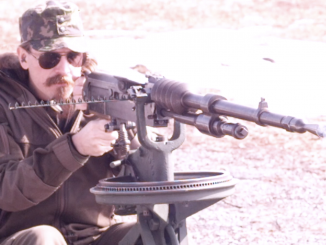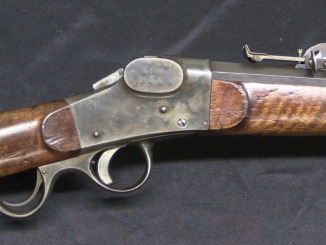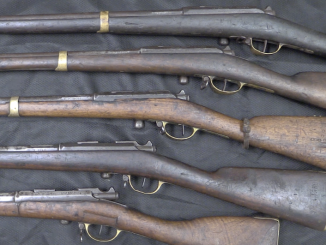There are few records I have been able to find on production of the original Mle 1866 Chassepot cavalry carbines. However, Royal Tiger / InterOrdnance just recently brought in a crate of 200 Gras and Chassepot-Gras cavalry carbines and I was able to help unpack and sort them. In the process, I found examples of all three main types of markings.
The pattern was adopted in 1869, and production began in 1870. The first roughly 55,000 at St Etienne were made under the Second Empire, and marked “Manufacture Imperiale”. Following the defeat of Napoleon III and the fall of the Empire, the marking changed to just “St Etienne” in large script letters. About 100,000 cavalry carbines were made with this marking, in 1871 and 1872. Finally, after the Third Republic was formed in 1873, a final 25,000 or so were made with the receiver marking “Manufacture d’Armes”.
The examples were are looking at today were all converted into metallic-cartridge Gras carbines in the late 1870s, as were the vast majority of Chassepot carbines – originals still firing paper cartridges are extremely rare today.




How many of these cavalry carbine will make it into your safe Ian?
This original crate of three hundred Gras and Chassepot-Gras cavalry carbines, er, *two* hundred Gras and Chassepot-Gras cavalry carbines…
Some settling may have occurred during shipping.
Mr McCollum. There is no “des armes”. Just d’armes. No S. And while I’m at it Saint is pronounced more like “Sant” rather than “sohnt”.
Ian MUST have walked away with at least one …
Wouldn’t you?
Not if my entire laboriously constructed business depended on the good will of the people who own the weapons, and my reputation as trustworthy and safe to grant access to hundreds of rare weapons. It would be like building up a good, profitable business as a bank consultant or interior designer only to risk it all for the sake of a $50 bill someone dropped on the floor. Even if they dont have proof to convict you, the moment they dont trust you any more, you are no longer welcome in any banks and you lose your entire business and income. You would have to be stupid. Not to mention straight dishonest to abuse their trust that way.
If anyone is wondering, the notch rear sight at the rear of the elevator was set for 200 meters, which is the reason for the “200” stamped on the base below it.
cheers
eon
any source on the hundreds of missing rear sights? And how were they attached? My carbine is (metal wise) in great shape, with a good bore. No rear sight, and the divot in the top barrel surface is smooth. Hard to say if anything was ever mounted, but there is no threaded hole or signs of welding. Also seems the barrel exterior was coated in something, that partially chipped off in antiquity.